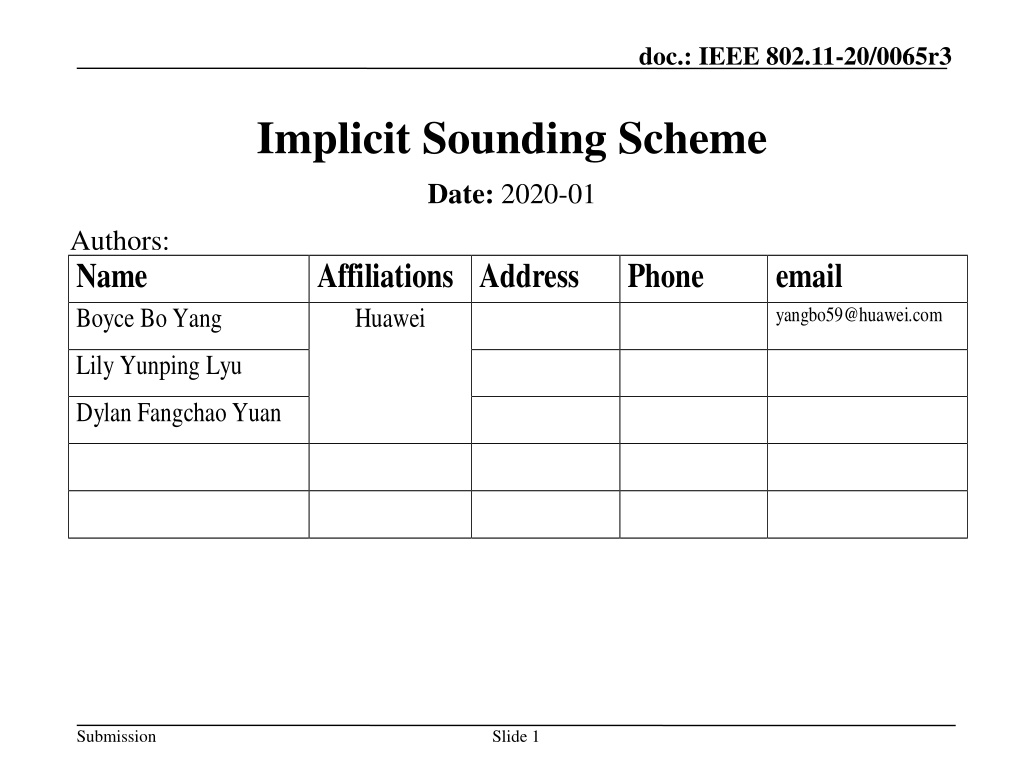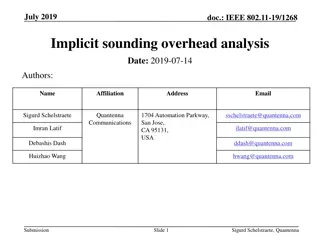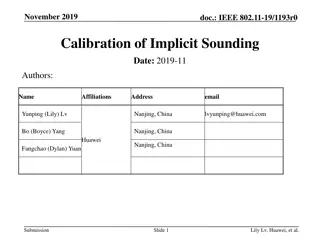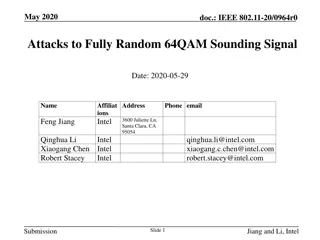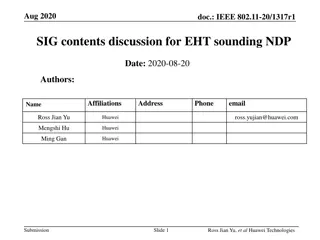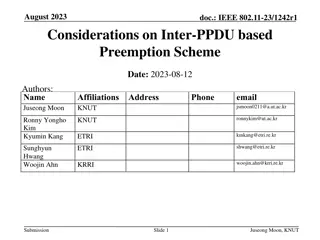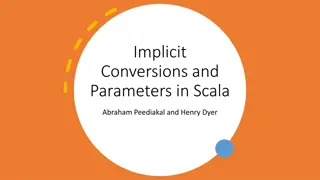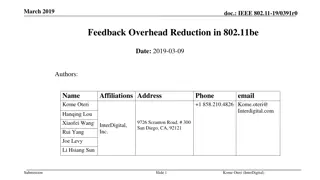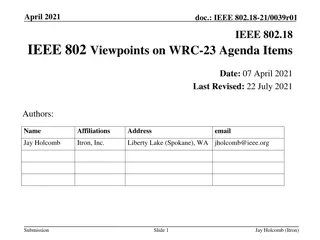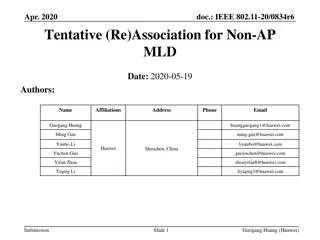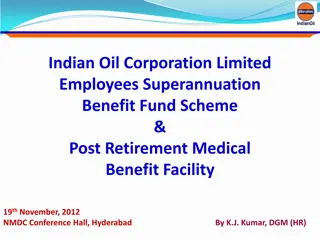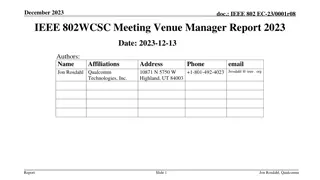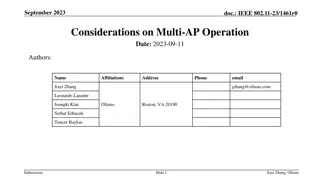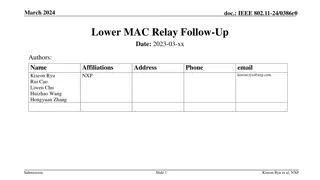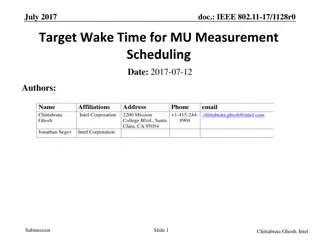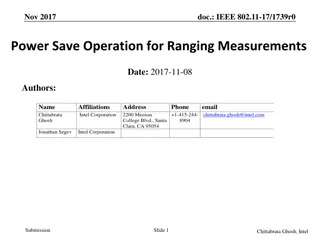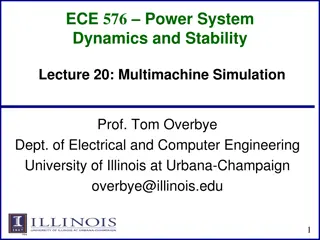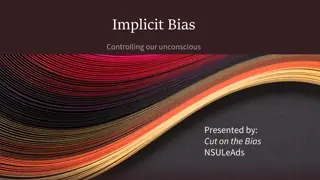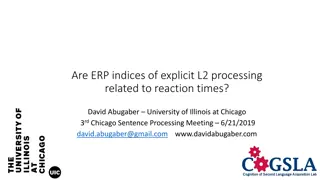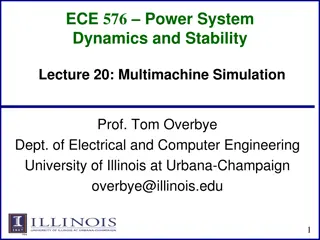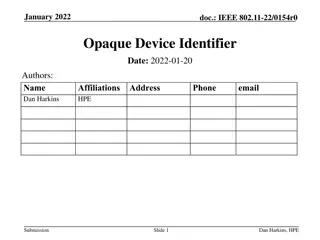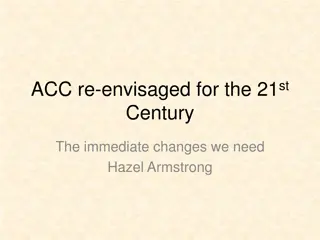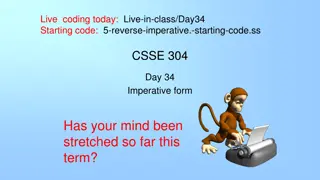Implicit Sounding Scheme in IEEE 802.11-20/0065r3
Implicit sounding schemes are analyzed in IEEE 802.11-20/0065r3 to address overhead issues in utilizing 11ax sounding schemes for advanced features like 16ss and multi-AP setups. Various challenges such as calibration accuracy, UL/DL power differences, and inter-user interference are discussed, highlighting the feasibility and benefits of implicit sounding approaches.
Download Presentation

Please find below an Image/Link to download the presentation.
The content on the website is provided AS IS for your information and personal use only. It may not be sold, licensed, or shared on other websites without obtaining consent from the author. Download presentation by click this link. If you encounter any issues during the download, it is possible that the publisher has removed the file from their server.
E N D
Presentation Transcript
doc.: IEEE 802.11-20/0065r3 Implicit Sounding Scheme Date: 2020-01 Authors: Name Boyce Bo Yang Affiliations Address Huawei Phone email yangbo59@huawei.com Lily Yunping Lyu Dylan Fangchao Yuan Submission Slide 1
doc.: IEEE 802.11-20/0065r3 Abstract There is overhead issue when using .11ax sounding scheme for candidate features of TGbe, such as 16ss, multi AP. Many contributions about how to reduce the overhead have been discussed, including improved explicit sounding and implicit sounding. In this contribution, we analyze the feasibility of implicit sounding schemes. Submission Slide 2
doc.: IEEE 802.11-20/0065r3 Implicit Sounding Schemes SU based multi-trigger sequential sounding STA transmits NDP sounding PPDU in response to the soliciting trigger frame containing its AID. In case of multi-AP, slave APs could be re-synchronized by the NDP-trigger frame and refresh channel information of the specified STA from the following NDP sounding PPDU. SU based single-trigger sequential sounding STAs transmit NDP sounding PPDU in response to the soliciting trigger frame containing their AIDs. Trigger frame contains information indicating the timing at which the STAs respectively transmit NDP MU based simultaneous sounding The difference to SU based scheme is that multiple STAs response NDP simultaneously, leveraging spatial multiplex. AP(slave) Trigger Trigger AP(master) Trigger Trigger NDP NDP NDP STA1 NDP NDP NDP STA2 SU: single-trigger SU: multi-trigger MU Submission Slide 3
doc.: IEEE 802.11-20/0065r3 Challenges of Implicit Sounding Calibration accuracy to maintain channel reciprocity [5] shows relative calibration is possible, adding no complexity to STA and estimating channel status accurately. UL/DL power difference Power offset among STAs MU based scheme Could develop STA selection algorithm to select STAs with similar power for MU-MIMO based scheme Inter-user interference caused by residual CFO scheme MU based In the following slides, we focus on the 2nd and 4th challenges. Submission Slide 4
doc.: IEEE 802.11-20/0065r3 UL/DL power difference In order to compensate for UL/DL transmission power difference, repetitions of EHT-LTF in NDP frame are required ChD: 20MHz AP NRX: 4,8 STA NTX : 1,2 STA Tx Power: 9 dBm Noise Power: -90 dBm HE-LTF repeated 1~20 times for implicit sounding HE-LTF mode: 4x, GI: 3.2 sec Based on various EIRP requirements and Wi-Fi products we define three main cases For MU based scheme or STA with >1 Nss, it s natural to have more than one HE-LTF, may not need additional HE-LTF for compensation. With repetitions of EHT-LTF, implicit sounding still have benefit in terms of overhead . Use Case Use Case Power Diff (dB) Power Diff (dB) #EHT-LTF #EHT-LTF Best Case Typical Case Worst Case 3 6 12 2 4 16 Submission Slide 5
doc.: IEEE 802.11-20/0065r3 Overhead Comparison Overhead comparison consumption Nss per user 2 2 2 2 4 2 2 2 2 1 1 #AP Tx Ant 8 8 16 16 16 16 16 8X2 16X2 4x4 4x4 MU-MIMO Size 2 1 4 6 2 1 4 2 2 1 12 # Use Case #users Power Difference Ng: 4 MCS: 3 BW: 20 MHz HE-LTF mode: 2x, GI: 0.8 sec Residential Residential Office Office Office Dense Network Dense Network AP Coop AP Coop AP Coop AP Coop Overhead comparison result considering repetitions of EHT-LTF 1 2 3 4 5 6 7 8 9 4 2 8 8 8 6dB 6dB 12dB 12dB 12dB 3dB 3dB 9dB 9dB 12dB 12dB 16 16 2 4 12 12 10 11 Explicit sounding Multi-trigger Single-trigger Feedback Procedure Duration ( sec) 10000 Duration 8000 6000 4000 2000 0 1 2 3 4 5 6 7 8 9 10 11 Submission Slide 6
doc.: IEEE 802.11-20/0065r3 Residual CFO in MU based Sounding Channel estimation accuracy is extremely important for 16ss and joint transmission. With number of concurrent user increasing, it requires much smaller CFO to achieve same level EVM as single user. ( Single user --- 350Hz, 8 users --- ~20Hz) 4800 STAs in the cell, 40cm apart ChD: 20MHz AP NRX: 8 STA NTX : 1 STA NSTA : 1, 2,4,8 STA Tx Power: 9 dBm Noise Power: -90 dBm CFO for Users: 0~350Hz HE-LTF mode: 4x, GI: 3.2 sec Submission Slide 7
doc.: IEEE 802.11-20/0065r3 Residual CFO in MU based Sounding Masked LTF in .11ax cannot maintain small CFO if there is Timing Offset. Timing Offset may be caused by 1) Distance between STAs and AP is different 2) A certain amount of symbol synchronization error (Detection Delay) introduced by implementation algorithm ChD: 20MHz AP NRX: 8 STA NTX : 1 STA NSTA : 6 STA Tx Power: 12 dBm Noise Power: -90 dBm CFO for Users: random( 200~350Hz HE-LTF mode: 4x, GI: 3.2 sec Conclusion: If no timing offset residual CFO is 10Hz @90%. If consider timing offset caused by propagation distance and implementation algorithm, residual CFO is impacted. Submission Slide 8
doc.: IEEE 802.11-20/0065r3 Replicated LTF(s) Replicate LTF(s) in NDP sounding frame can solve the problem. 2x2 example Group 2 Group 1 EHT-LTF EHT-LTF EHT-LTF EHT-LTF EHT-LTF EHT-LTF ?2 2 EHT-LTF EHT-LTF EHT-LTF EHT-LTF EHT-LTF EHT-LTF ChD: 20MHz AP NRX: 8 STA NTX : 1 STA NSTA : 6 STA Tx Power: 12 dBm Noise Power: -90 dBm CFO for Users: random( 200~350Hz HE-LTF mode: 4x, GI: 3.2 sec Conclusion: Timing offset has no impact on residual CFO when using replicated LTF(s). Residual CFO is <5Hz @90% Submission Slide 9
doc.: IEEE 802.11-20/0065r3 More simulation on Replicated LTF(s) ChD: 20MHz AP NRX: 8 STA NTX : 1 STA NSTA: 4,6 STA Tx Power: 3,6,9,12,15 dBm Noise Power: -90 dBm CFO for Users: random( 200~350Hz HE-LTF mode: 4x, GI: 3.2 sec Conclusion: Residual CFO of STA is always within 10Hz, no big difference when number of MU increases. Submission Slide 10
doc.: IEEE 802.11-20/0065r3 Summary We discussed several implicit schemes, including SU- based and MU-based. Repetitions of EHT-LTF can solve UL/DL power difference issue and residual CFO issue in MU based scheme. Based on the analysis, we propose implicit sounding as an option in TGbe to help improve sounding efficiency. Submission Slide 11
doc.: IEEE 802.11-20/0065r3 SP1 Do you support to introduce implicit sounding as an optional mode in TGbe? Y: N: Abstain: Submission Slide 12
doc.: IEEE 802.11-20/0065r3 SP2 Do you support to enable non-simultaneous NDP response with multiple trigger for implicit sounding? Y N Abstain AP(slave) AP(master) Trigger Trigger NDP STA1 NDP STA2 Submission Slide 13
doc.: IEEE 802.11-20/0065r3 SP3 Do you support to enable non-simultaneous NDP response with single trigger for implicit sounding? Y N Abstain AP(slave) Trigger AP(master) NDP STA1 NDP STA2 Submission Slide 14
doc.: IEEE 802.11-20/0065r3 SP4 Do you support to enable simultaneous NDP response for implicit sounding? Y N Abstain AP(slave) Trigger AP(master) NDP STA1 NDP STA2 Submission Slide 15
doc.: IEEE 802.11-20/0065r3 References [1] 19/1268 Implicit sounding overhead analysis [2] 19/767 Implicit Channel Sounding in IEEE 802.11 (Feasibility Study) [3] 18/1191 MU sounding improvements [4] 19/768 Implicit Channel Sounding in IEEE 802.11 [5] 19/1939 Calibration of Implicit Sounding Submission Slide 16
doc.: IEEE 802.11-20/0065r3 Month Year Backup Submission Slide 17
doc.: IEEE 802.11-20/0065r3 MU-MIMO Based Implicit Sounding Challenge Replication LTF could also work on the residual CFO problem. Take 2x2 UL MU-MIMO for example. If there is no residual CFO, H= Y? ? P matrix 1= 11+ 12 2= 11+ 12 -1,1 ?1 ?1 1 1 1 1 1 1 2 2= ?1 ?2 ?1 ?2 11 21 12 22 STA1 ??? ??? ??? ??? 1 1 1 1 1 AP Assume residual CFO of STA1 and STA2 are ??and ??respectively, H=Y???? ???? matrix 1,1 ? 1= 21+ 22 2= 21+ 22 ?2 ?2 STA2 1 2 2= ?1 ?2 ?1 ?2 11 21 12 22 1??2? ?1? 1??2? ?2? ??? ??? ??? ??? 1 1 1 By replicating LTF on STA side, residual CFO between STA and AP( ?? and ??) can be calculated, then with ????, inter-user interference is eliminated and H could be got correctly. Submission Slide 18
doc.: IEEE 802.11-20/0065r3 MU-MIMO Based Implicit Sounding Challenge ???? Original LTF 1 2 2= ?1,2=?1 ?1 ?2 11 21 12 22 1??2? ?1? 1??2? ?2? ????,??? 1 1 1 ?2 3 4 4= Replicated LTF ?3,4=?1 ?1 ?2 11 21 12 22 1??2? ?12? 1??2? ?22? 1??2? ?13? 1??2? ?23? 3 ?2 11 21 12 22 ??2? ?12? 0 1??2? ?1? 1??2? ?2? 0 1 1 = ??2? ?22? 1 ?3,4 on AP side, ?? and ??can be By Eigenvalue Decomposition of ?1,2 calculated. 1??2? ?12? 1??2? ?1? 1??2? ?2? 1??2? ?1? 1??2? ?2? 1 ?3,4=1 0 1 1 ?1,2 ??2? ?22? 1 0 Submission Slide 19
